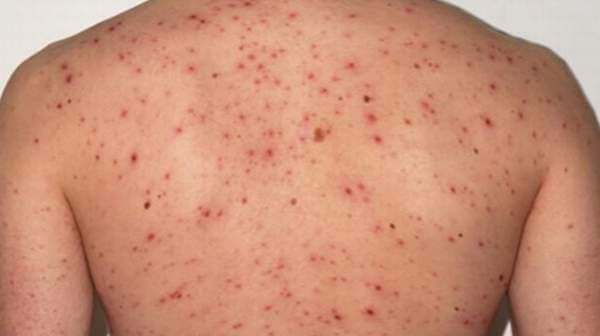What's in this article?
The HIV Rash
A skin rash is a common symptom of HIV infections. It is an early indication in most cases and occurs within two to three weeks after you have contracted the virus. However, skin rashes can be caused by other, less dangerous factors too, like an allergic reaction or a skin issue. When in doubt, you should go see your doctor and get tested for HIV. This will ensure you receive the correct treatment for your condition.
Acute HIV Rash- A Symptom of HIV Infection
When people are first infected with HIV, they may experience an acute, ‘flu-like’ illness called a ‘seroconversion illness,’ about 2-4 weeks after being infected. The HIV rash is a symptom of this condition.
The rash will mostly affect the upper part of the body and will probably be found on the shoulder, chest area (as in the picture below), face, torso and palms of the hands.
Typically the rash will be flat or barely raised with small reddish dots/ spots (resembling eczema) in people with light skin, and dark purple/ black in people with dark skin.
The rash is not usually itchy and it tends to disappear within 3 weeks.
What To Do If You Notice A HIV Rash
If you do notice this kind of rash and it’s associated with any other acute symptoms of HIV, you should get HIV tested immediately.
You can order an HIV test kit online from one of our doctors, and find out your status within two days.
Over-the-counter medications like Benadrul or Hydrocortisone Cream can be used to heal rash and lessen itching.
Try to avoid hot baths, showers and direct sunlight if possible.
Causes of Rash in HIV
Rash in a HIV patient may be caused by many reasons. As follows:
HIV infection
Usually, rashes are more commonly seen in viral infections. Being one among them, almost all HIV infected people experience skin changes at some stage of the disease and rash is the most common skin manifestation of HIV.
Opportunistic infection
As said above, a person infected with HIV has poor ability to fight against many diseases which are easily overcome by people with normal immune system. These diseases are mostly seen among HIV patients and in some other conditions that cause poor immune status like diabetes and are called opportunistic infections. Most of the opportunistic infections cause a rash. The common opportunistic infections in AIDS associated with rash are
Molluscum contagiosum
It is a viral infection which can be present in both adults and children.
Herpes simplex
Herpes simplex is a viral disease. In most conditions, patients with HIV have previous history of exposure to Herpes simples which gets reactivated. There is less reports on HIV patient acquiring Herpes simplex for the first time.
Herpes Zoster/ Shingles
It is a viral infection in adults caused by the virus which causes chicken pox in children.
Kaposis Sarcoma
This is a type of cancer seen in AIDS patients which begins as brown, purplish or red skin lesions which darken and become numerous in later stage.
HIV medications
The most common side effect of HIV medications is rash and rashes are 100 times more frequent with usage of these medications. Almost all anti HIV medications have the potential to cause rash. But it is mostly caused by NNRTI – Non nucleotide reverse transcriptase inhibitor especially Nevirapine. Women have a higher risk of getting a rash than men by Anti HIV drugs.
Allergic Reaction
As HIV is a disease of the immune system, there are changes in the system that makes a person allergic or hypersensitive to substances which didn’t bother him before, like sunlight and chemicals.
For example Papular Pruritic Eruption or the Itchy red bump disease is an allergic reaction to insect bite in which there is an intensely itchy rash that occurs over the trunk and extremities. It is the common skin manifestation of HIV patients in Sub Saharan Africa.
What is Chickenpox?
Also known as varicella, chickenpox is a virus that often affects children. It is characterized by itchy, red blisters that appear all over the body. Chickenpox was once so common it was considered a childhood rite of passage. It is very rare to have the chickenpox infection more than once.
Symptoms of Chickenpox
Chickenpox often starts with a fever, headache, sore throat, or stomachache. These symptoms may last for a few days, with the fever in the 101°-102°F (38.3°-38.8°C) range.
Chickenpox causes a red, itchy skin rash that usually appears first on the abdomen or back and face, and then spreads to almost everywhere else on the body, including the scalp, mouth, arms, legs, and genitals.
The rash begins as multiple small red bumps that look like pimples or insect bites, usually less than a quarter of an inch wide. They appear in crops over 2 to 4 days and develop into thin-walled blisters filled with fluid. The blister walls break, leaving open sores, which finally crust over to become dry, brown scabs. The rash is very itchy, and cool baths or calamine lotion may help to manage the itching.
A hallmark of chickenpox is that all stages (red bumps, blisters, and scabs) can appear on the body at the same time. The rash may be more extensive or severe in kids who have skin disorders like eczema or weak immune systems. Young kids tend to have a mild illness with fewer blisters than older children or adults.
In rare cases, serious bacterial infections involving the skin, lungs, bones, joints, and the brain can happen.
Treatments for chickenpox
Chickenpox is usually mild and can be treated at home. Most people feel better within a week or so.
There’s no cure, but the treatments below can help relieve the symptoms while the body fights the infection.
It’s also important to observed following steps below to prevent chickenpox spreading, such as staying off work or school until the last blister has dried and crusted over.
Painkillers
If you or your child have a high temperature (fever) and feel uncomfortable, over-the-counter painkillers can help.
Prevent itching and scratching
Chickenpox can be very itchy, but it’s important not to scratch the spots as it can increase the chances of the skin becoming infected with bacteria and could result in scarring.
Food and drink
It’s important to drink plenty of fluids to avoid dehydration.
Water is better than sugary, fizzy or acidic drinks – particularly if you or your child has chickenpox spots in the mouth.
Sugar-free ice lollies are also a good way of getting fluids into children and can help soothe a sore mouth.
Antiviral medication
An antiviral medicine called aciclovir may be recommended if you’re at risk of severe chickenpox and you already have symptoms.
Immunoglobulin
Immunoglobulin is a treatment given by injection that can help prevent severe chickenpox if you’ve been exposed to someone with the infection but don’t have any symptoms yet.
Difference Between HIV Rash and Chickenpox
Chickenpox is characterized by itchy maculopapules that evolve into vesicles over hours to days, then eventually form crusts. Typical lesions first appear on the trunk and face and rapidly spread to involve other areas. While HIV can also cause a non-itchy maculo-papular rash, similar in appearance, but mainly localised to the trunk and upper limbs, it does not crust over either. It would normally appear sometime between 2 and 6 weeks after the infection (between 14 and 42 days), not lasting more than 1-14 days, and almost always accompanied by a high fever and a severe sore throat with general malaise.






Leave a Comment